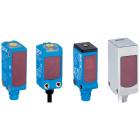Why Choose Us?
- Competitive Prices
- Hands on Support
Sick photoelectric
Photoelectric sensors have been used in industrial controls since the late 1940’s. A photoelectric sensor has two main components: an emitter and a receiver. The emitter contains the light source, which is either an LED or a laser. The emitter's light source is pulse-modulated by an oscillator. The receiver contains an optoelectronic element, such as a phototransistor or a photodiode which detects the light from the emitter, and converts the received light intensity to an electrical voltage. That voltage is amplified and demodulated. The receiver is "tuned" to the pulse frequency of its emitter, and ignores all of the other ambient light, which is gathered by its lens. The receiver is set to produce an output signal, which occurs either above or below a specified intensity of the light received from its emitter. Most sensors allow adjustment of how much light will cause the output of the sensor to change state.































Our Social Media Channels